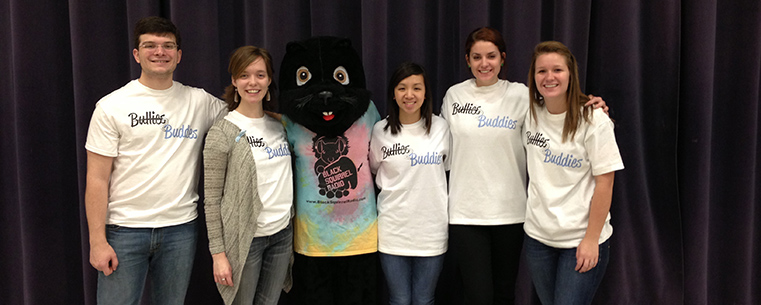Two teams of ÃÏÃÏ≥‘πœ public relations students are competing in this year‚Äôs 2013 Bateman Case Study Competition where they have been presented with the challenge to develop a campaign to increase awareness and inform key audiences about the effects of bullying.
“This class is different from PR Campaigns, the senior capstone class, because the students have to implement and evaluate their plan,” said Tim Roberts, School of Journalism and Mass Communication lecturer and Bateman class advisor.
The Bateman Gold Team, including Robert Batyko, Megan Corder, Cindy Deng, Bethany Johnson and Shannen Laur, has brought its campaign “Bullies to Buddies” to Stanton Middle School. Bateman Blue, including Kirsten Bowers, Wezley Garlick, Mary Kate Garvey, Caitlin Potts, and Lyndsey Sager, implemented its campaign “Pledge to Prevent: Bullying Stops Here” at Rootstown Middle School. The class is invitation only and all members have been recommended to work on this campaign.
The competition is sponsored by the Public Relations Student Society of America (PRSSA), a national, pre-professional, public relations organization. All Bateman members must be PRSSA ÃÏÃÏ≥‘πœ members. Both teams worked with professional advisors who are ÃÏÃÏ≥‘πœ State alumni. Jenn Yokley, corporate communication manager of the Cleveland Cavaliers, coached Bateman Gold. Erin Orsini, an associate with True Digital Communications, worked with Bateman Blue.
Bateman Gold has used a guidance counselor at Stanton Middle School as a resource in its “Bullies to Buddies” campaign to help bring its tactics to life. Team members have worked with her to supplement the activities and programs already in place about bullying. The group went into the classrooms for three days and taught students about bullying.

“We’re trying to work our way into the system,” Deng said. “We set up a webpage for our campaign so we can get the word out to parents. We found through our research that parents aren’t really involved as much as they should be. We handed out parent brochures in school so they understand their kids are being taught anti-bullying messages in school. An incentive to get the parents to read the brochure is that they can sign a ticket that will be entered into a drawing for different prizes.”
Bateman Blue’s research found that a bystander can really make a difference in an instance of bullying. The team did a benchmark survey of all the students in the school, sixth through eighth grade, and went in during lunch periods to teach lessons on bullying and do activities with the students.
“If a bystander says nothing, then the bullying will continue,” Bowers said. “If they stick up for the victim, it’s more likely to stop. We really wanted to focus on getting student bystanders to intervene and know what they can do to help.”
Bateman Gold used activities in the classroom to get students to brainstorm nice affirmations to say to each other to boost self-confidence.
“We had them split into groups and trace the outlines of two people,” Laur said. “On one outline we had them write the mean phrases that they’ve heard or said to somebody and on the other, nice phrases they’ve heard or said. We then had them rip up the negative phrases to reinforce that you don’t have to hold onto those negative feelings.”
Both teams found during their research that students at school encounter a lot of bullying online through social media.
“These students act a lot older than we did when we were 12 and 13 years old,” Laur said. “They all sit at lunch with their iPhones looking at Facebook and Instagram. These kids attack each other through it; it’s definitely different from what I remember when I was in middle school.”
“Some of the things they know and are exposed to, I never had to worry about in middle school,” Corder said.
Although it’s been hard work for each group this semester, seeing the impact and change they’re helping to make in these students’ lives is rewarding.
“Some of these kids won’t listen, and some will ignore it,” Batyko said. “But the important thing is some of them will listen, and these messages will hit home and make a difference in their lives.”
“It’s hard to tell sometimes if we are getting through to the students,” Potts said. “One day we were packing up to leave Rootstown Middle School and this woman comes up to us from the cafeteria. She asked if we were the team helping the students with bullying and said ‘I just want to say that my daughter is going to be in middle school next year and you guys are really inspiring. As a parent, it’s really great to know that you guys are doing this.’ It was really nice and reassuring to hear that.”
For all students, this campaign has really opened their eyes to the issue of bullying and how bad it can be for some students.
“What I’ve learned during this campaign is just overwhelming,” Corder said. “It’s really surprising to see how bad bullying can be for some students.”
“You don’t think bullying is happening that much, but it really is,” Bowers said.
